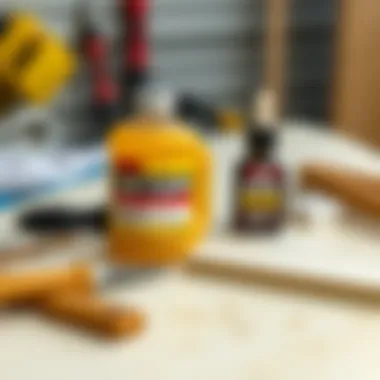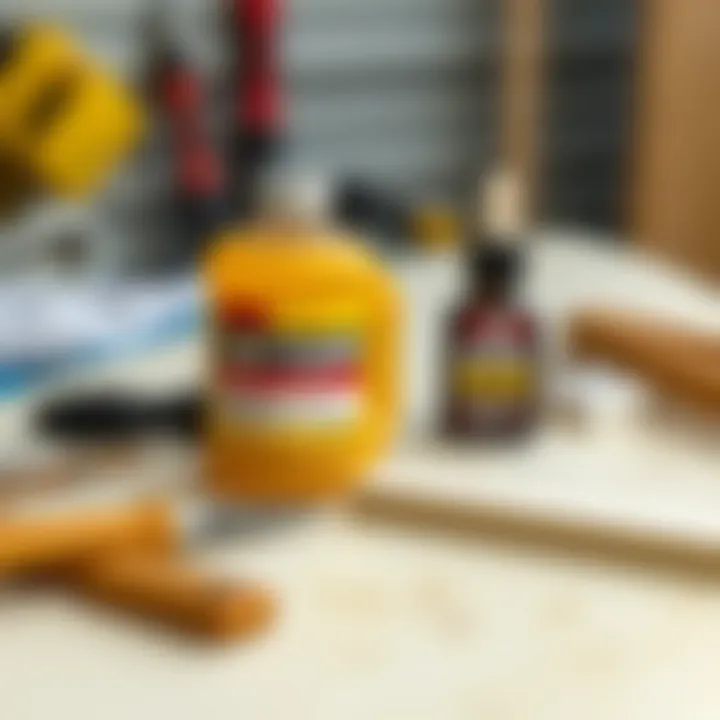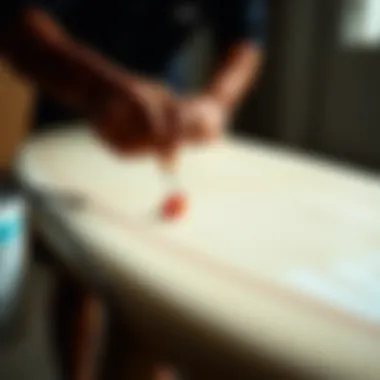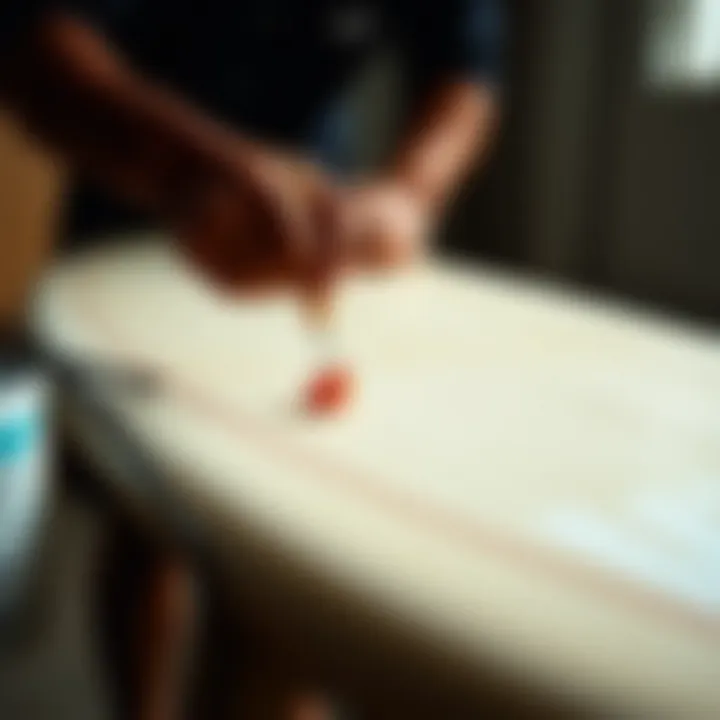Expert Guide to Fiberglass Surfboard Repair Techniques


Intro
Surfing isn't just a sport; it's a way of life. As anyone who's ever hit the waves knows, your surfboard is your trusty companion. Yet, like all good things, it can face its fair share of wear and tear. Each ding, crack, or scratch tells a story about epic rides, thrilling wipeouts, and adventure-filled days. Repairing a fiberglass surfboard doesn’t have to be daunting. With a bit of know-how and the right tools, you can keep your board in top shape.
This guide looks at how to repair fiberglass surfboards, covering everything from common types of damage to the best materials for effective fixes. We'll break down the process, giving you the tools to tackle your repairs confidently. By the end, you’ll know how to extend the lifespan of your beloved board, ensuring countless more wave-riding adventures.
Common Damages to Fiberglass Surfboards
When it comes to fiberglass surfboards, certain damages crop up more often than others. Understanding these common issues is step one in your repair journey. Here are a few to keep an eye out for:
- Dings and Dents: Often caused by collisions with rocks or other boards. They can compromise the integrity of your surfboard.
- Cracks: These can be superficial or reach deeper into the core of the board. Band-aid fixes won’t cut it here.
- Delamination: This usually occurs between layers of fiberglass and resin, often showing bubbling or separation.
- Nose and Tail Damage: This happens especially due to impact from falls or rough handling.
Recognizing these issues will prepare you to repair them right.
Essential Tools and Materials for Repairs
Before diving headlong into repairs, it’s prudent to gather your gear. Here’s a handy checklist to get you started:
- Sanding Block: Smooths the damaged area for a better bond.
- Fiberglass Cloth: Essential for adding strength back into the board.
- Epoxy or Polyester Resin: Choose based on your board’s material. Epoxy is generally sturdier if your board is built with epoxy resin.
- Mixing Cups and Stirring Sticks: For combining resin and hardeners.
- Paint Mask: Safety first! Protect yourself from those toxic fumes.
- Plastic Spreader: Ideal for applying resin evenly.
Having these tools at your disposal simplifies the repair process and boosts your likelihood of success.
Step-by-Step Repair Process
Repairing fiberglass boards can actually be quite straightforward. Let's break it down into bite-sized steps:
- Assess the Damage: Determine what needs fixing and how severe the damage is.
- Clean the Area: Remove any debris, dirt, or water around the damage. A clean workspace is essential.
- Sand the Affected Area: Using your sanding block, smooth out the damaged section to ensure a good bond.
- Cut Fiberglass Cloth: If you’re dealing with a significant crack or ding, cut a piece of fiberglass cloth to size, ready to patch the area.
- Mix Resin: Carefully follow the instructions on your resin for mixing. This typically involves combining resin with a hardener.
- Apply the Mixture: Using your plastic spreader, apply the resin over the damaged area, ensuring you include the edges of the fiberglass cloth.
- Cure Time: Let it cure. Don't rush this part. Follow the resin’s instructions for timing.
- Finish Sanding: Once cured, sand the area again to create a smooth finish.
- Polish: For a glossy look, consider using a polish designed for fiberglass.
By following these steps, you help ensure that your repair job is thorough. It’s a bit like a second chance; treat your board well, and it’ll treat you right.
"A smooth sea never made a skilled sailor."
Even with the best care, things will still wear out. Understanding repair techniques for fiberglass surfboards empowers you to seamlessly patch up those little mishaps that come with the territory.
Environmental Considerations
Repairing your surfboard also ties into broader themes of sustainability. By fixing rather than discarding, you’re contributing to a reduction in waste. The surf culture increasingly embraces sustainable practices. As surfers, we have a responsibility to care for our oceans and ecosystems. This mindset isn't just about our boards but extends to all surf-related gear and practices.
For more detailed information on eco-friendly surf practices, you can explore resources such as Surfrider Foundation and Save The Waves Coalition.
Understanding fiberglass repair isn’t just practical; it's a step toward a more sustainable surfing culture. So, grab your tools, and let's get those boards ready for the next wave!
Preface to Fiberglass Surfboard Repair
When surfers hit the waves, their fiberglass surfboards are not just equipment; they are lifelines to thrilling experiences. Over time, however, these boards can face all kinds of wear and tear. This is where understanding fiberglass surfboard repair becomes crucial. Repairs are not merely a matter of aesthetics. They directly affect performance on the water and the longevity of the surfboard itself.
Why Repairing is Essential
Imagine paddling out into the ocean only to discover your board has a ding. It can be quite disheartening. A repaired board means less time worrying about your gear and more time focused on the waves. Conducting regular upkeep can save money in the long run. Instead of shelling out for a brand-new board, a simple repair can extend the lifespan of your current gear.
Moreover, for those who care about the environment, repairing instead of replacing contributes positively to sustainability. Fiberglass doesn't decompose easily, so keeping your board in use is a step toward minimizing waste.
Key Benefits of Understanding Repairs
Gaining knowledge about fiberglass surfboard repair opens up a world of possibilities. A few key benefits include:
- Cost-effectiveness: Repairing minor damage can prevent larger issues that might require expensive fixes.
- Skill Development: Learning repair techniques can improve your overall understanding of surfboard functionality.
- Performance Maintenance: A well-maintained board performs better, providing a smoother ride.
"A stitch in time saves nine." Proper attention to minor dings can prevent major headaches down the line.
In essence, equipping oneself with the knowledge of fiberglass repairs not only enhances the surfing experience but also fosters an appreciation for the equipment itself. Surfers become more than just users; they transform into stewards of their boards, maintaining them with care and respect.
As we delve deeper into this guide, we will explore the various aspects of fiberglass surfboards, damage types, and innovative repair methods. With this information at hand, not only will you learn how to fix your board, but you'll also gain insight into preserving your surfing passion for years to come.
Understanding Fiberglass Surfboards
In the world of surfing, fiberglass surfboards have carved out a niche that combines performance with precision. While riding the ocean waves is exhilarating, understanding the finer details of your board can greatly enhance both your surfing experience and its longevity. Those who are keen on keeping their surfboards in top shape will realize that being well-acquainted with what goes into these boards plays a crucial role in effective repair.
Construction Process
Fiberglass surfboards are constructed using a combination of materials and processes that lend themselves to their unique characteristics. At their core, these boards typically use a foam core—most often polystyrene or polyurethane—that provides buoyancy and shape. This core is then enveloped in layers of fiberglass cloth soaked in a resin mixture (commonly epoxy or polyester). The careful application of these materials is what grants a surfboard its strength, flexibility, and ability to withstand the rigors of the sea.


The construction process can be summarized in a few clear stages:
- Shaping the Core: Crafting the foam core into the desired shape, taking into account the specific design and performance characteristics.
- Layering Fiberglass: Carefully layering fiberglass cloth around the shaped core. Precision is key here; too much or too little resin can affect the board's durability.
- Curing: Allowing the resin to harden fully, a critical step to ensure the bond between the foam and fiberglass is strong.
This meticulous construction process contributes to how well a board performs in the water, making it essential for surfers to understand the basics of their equipment. Knowing how these boards are built provides valuable insights when it comes to maintaining and repairing them.
Advantages of Fiberglass
Fiberglass surfboards hold a number of advantages that keep surfers coming back for more, creating a blend of performance qualities appreciated by both novices and seasoned riders.
- Strength and Durability: Fiberglass boards can take a beating. The combination of the resin and fiberglass bonding ensures less wear and tear, making them ideal for surfers who frequently confront harsh ocean conditions.
- Lightweight Nature: Though they may appear robust, fiberglass boards are surprisingly light, providing surfers with handleability that allows for more dynamic movements on waves.
- Customizability: Whether it's about paint jobs or board shapes, fiberglass boards can be tailored to fit personal style and performance needs, giving surfers the ability to express themselves while enjoying their craft.
- Versatile Performance: With a good balance between rigidity and flexibility, these surfboards enable both speed and control, essential for executing sophisticated maneuvers in various wave conditions.
In summary, understanding the construction process and advantages of fiberglass surfboards not only enhances the knowledge that leads to better surfing but also paves the way for more informed repair strategies. This comprehension is a stepping stone towards ensuring that your board remains in top shape, ready to ride the next wave, no matter the conditions.
Types of Damage in Fiberglass Surfboards
When it comes to maintaining a fiberglass surfboard, understanding the types of damage that can occur is crucial. Each type of damage has its own implications on performance, safety, and the longevity of your gear. By recognizing these issues early on, surfers can address them promptly, ensuring their boards remain in prime condition for every wave. This section delves into three main forms of damage: dings and cracks, delamination, and water damage. Grasping the nature of these issues not only aids in effective repairs but also highlights the importance of care in the everyday use of your surfboard.
Dings and Cracks
Dings and cracks are arguably the most common form of damage seen on fiberglass surfboards. These blemishes often come from minor collisions, dropping the board, or other incidental mishaps when out in the water. The issue with dings and cracks isn’t just cosmetic; they can compromise the structural integrity of the surfboard, which can hinder performance.
In many cases, surfers might just shrug off a small ding as "no biggie", but over time, a small crack can lead to larger issues. For instance, if water seeps into a crack, it can worsen delamination, which is another critical problem. Here’s an important point to remember: repairs for dings and cracks, if handled early, are typically straightforward, but procrastination can lead to costly fixes later on. Regularly inspecting your board for these issues can save you time and money down the line.
Delamination
Delamination is a more severe type of damage that occurs when the layers of fiberglass begin to separate from each other. It can manifest due to heat exposure, water intrusion, or manufacturing defects. This issue often alters the feel of the board, impacting control and responsiveness while surfing.
When delamination sets in, it doesn’t just impair performance; it can also create pockets where water can accumulate, leading to further issues like mold and rot if not addressed. Repairing delamination requires careful handling, often involving addressing the specific areas of separation, often with resin fillers. For those who take their surfing seriously, recognizing delamination early can be the key to preserving the performance of the board and avoiding more extensive repairs later.
Water Damage
Water damage is a lurking danger for all surfers. Fiberglass surfboards are designed to withstand some water exposure, but if the board is not adequately sealed, it can absorb moisture over time. This prolonged moisture exposure can lead to decreased buoyancy, deterioration of the materials, and a significant loss in overall performance.
Water damage may occur simultaneously with other damages like dings or cracks, further compounding the problems. It's essential to check the entirety of the board after a wipeout or impact to ensure no water has been trapped inside. Repairing water damage typically involves drying out the board thoroughly, which can require a significant amount of time and effort.
"An ounce of prevention is worth a pound of cure." Stay vigilant in your surfboard inspections to avoid the pitfalls of water damage.
In summary, an adept surfer needs to understand these types of damages to effectively manage repairs and keep their surfboard in top form. Addressing dings and cracks promptly, being aware of the signs of delamination, and monitoring for any signs of water damage can significantly extend the lifespan of your fiberglass surfboard.
Essential Tools and Materials
When it comes to fiberglass surfboard repair, having the right tools and materials can make the difference between a successful fix and a project gone wrong. This section sheds light on why these essentials are crucial for any surfer looking to maintain their board’s performance and longevity.
Tools Needed for Repairs
The success of any surfboard repair hinges on the quality and appropriateness of the tools at your disposal. Not all tools are created equal — the wrong tool can lead to sub-par results, or worse, further damage. Here’s a rundown of some indispensable tools:
- Sandpaper (various grits): This is a must-have for smoothing out the repaired area. Using coarse sandpaper initially, followed by finer grits, ensures a smooth finish.
- Fiberglass cloth: Essential for reinforcing the damaged area. It’s available in different weights, suitable for various types of repairs.
- Mixing containers: Whether you're working with resin or epoxy, proper mixing containers help in combining materials accurately, avoiding contamination.
- Brushes: For applying resin, brushes of various sizes enable a smooth application, crucial for achieving an even surface.
- Utility knife or scissors: These tools are handy not just for trimming fiberglass cloth but also for cutting sandpaper to size.
- Protective gear: Don’t overlook the importance of masks, gloves, and goggles. Safety should be your top priority when working with potentially hazardous materials.
Each tool has its purpose from shaping to finishing, which contributes to the overall health of your surfboard.
Materials for Repair Process
With the tools squared away, the next step involves understanding the various materials needed to carry out effective repairs. The right materials not only facilitate a strong bond but also ensure the repair is as seamless and unnoticeable as possible. Here are some key materials to consider:
- Epoxy Resin: Frequently used due to its strength and flexibility, epoxy is great for most repairs. It dries clear and offers excellent adhesion to fiberglass.
- Polyester Resin: This is another popular choice but be mindful of its limitations, especially in moisture resistance. It is generally less weatherproof than epoxy.
- Fiberglass Repair Paste: This is useful for dings and minor cracks, providing a quick and effective way to seal damaged areas without extensive labor.
- Color pigments: If you want to match the color of your surfboard post-repair, color pigments can be mixed into the resin to achieve a close match.
- Hardener/Catalyst: This component is vital when mixing with resin. It determines the curing time and final strength of your repair. Be sure to follow the manufacturer's instructions for optimal results.
Not only do these materials provide the structural integrity needed in repairs, but they also play a role in how professional and smooth your end result appears.
Key Takeaway: The right tools and materials not only expedite the repair process but also enhance the durability and appearance of your surfboard, keeping it in prime condition for the waves.
Preparing for the Repair
Before embarking on the journey of repairing a fiberglass surfboard, it is crucial to lay a proper foundation through preparation. This phase helps ensure that the repair process runs smoothly and yields a durable and functional result. By adequately setting up the workspace and organizing necessary materials, you can effectively minimize mistakes and achieve a professional finish. Here, we will explore in detail two key elements that must be addressed in the preparation phase: assessing the damage and cleaning the area.
Assessment of Damage
Assessment of damage is the first step that surfers must take to understand the extent of repairs needed. Often, surfboards sustain various types of wear and tear, from tiny dings to large cracks. By examining these imperfections closely, you can determine whether a simple fix will suffice or if a more extensive repair is required.
- Visual Inspection: Look for any signs of cracks, dings, or discoloration. This could be the first indicator of underlying issues. Use good natural light if possible, as it helps to reveal the paint or gel coat damage that might not be obvious under artificial lighting.
- Tap Test: Lightly tapping around the area can help identify delamination. A dull sound typically denotes a weak spot, while a solid sound indicates a strong area. This method can provide insights on how much of the board might need repair.
- Consider the Age and Condition: The history of the board is important too. Consider how often it's been used, where it’s been surfed (rocky, reef breaks versus sandy beaches), and its overall condition. Older boards may require additional reinforcement during repairs.
Assessing the damage correctly will not only save time but will help you approach repairs with clarity.


Cleaning the Area
Once the damage has been assessed, cleaning the area thoroughly is paramount. A clean workspace sets the stage for effective repairs and helps materials adhere correctly.
- Removing Debris: Use a fine-grit sandpaper to carefully sand around the damaged area. This helps to create a rough surface, allowing the resin to bond better. Make sure to remove any loose fragments or old wax from the board’s surface.
- Wipe Down with Solvent: After sanding, use a clean cloth and a solvent like acetone to wipe down the area. This step removes any grease, dust, or oils that may interfere with the adhesion of your repair materials. It is vital to allow the area to dry completely after this step.
- Check Surrounding Areas: While you're at it, inspect the nearby areas on the surfboard for any upcoming issues. Prevention is better than cure, and treating minor scrapes or fading paint now might save you from a hefty repair job later.
A meticulously cleaned area not only guarantees a better bond and finish but also promotes a smoother repair process.
"Good preparation makes for good repairs; it’s like the calm before the storm."
In summary, taking the time to assess damage thoroughly and cleaning the area appropriately will make a significant difference in the quality of your surfboard repairs. Rushing through these steps can lead to more significant issues down the road, not to mention a less satisfying surfing experience. So gear up, take the leap into the preparation phase, and set your surfboard on the path to recovery.
Repair Techniques
Repair techniques are vital for keeping fiberglass surfboards in prime shape. Surfboards face wear and tear quite regularly given their usage, and knowing how to effectively mend them can enhance your surfing experience and extend the life of the board significantly. It’s like knowing the ins and outs of a car; if it breaks down, you don’t want to be stranded without a mechanic's knowledge. For surfers, having the ability to handle repairs ensures that they can quickly get back on the water without missing a beat.
Fixing Dings and Cracks
Dings and cracks can be inevitable for anyone who spends considerable time on a surfboard. A small ding can lead to bigger problems if not addressed promptly. Fixing dings typically involves several simple, yet crucial steps. First off, cleaning the area around the damage is a must. This removes dirt and debris that could prevent proper adhesion of repair materials. You don't want to slap on some resin over grime, do you?
Once clean, the next step is to prepare the surfboard’s surface. Typically, this means lightly sanding the damaged area to create a rough texture. It's like giving the repair surface some teeth to bite into. Then you can mix your resin according to the manufacturer's instructions.
After mixing, you apply the resin directly over the ding, ensuring it fills the cavity completely. Smoothing it out is key, so the surface remains flush with the surrounding area. Allow adequate time for curing. Patience is often rewarded—rushing will only lead to future hiccups. Finally, finish by sanding the area once it’s dry to make it perfectly even with the board.
Addressing Delamination
Delamination is when the layers of fiberglass start to separate from the foam core of your surfboard. It’s a significant issue that can compromise not only your board's integrity but its overall performance as well. Fixing delamination can be a tad more complicated than a simple ding. The first step in addressing this is to identify the affected areas by applying pressure and listening for any hollow sounds.
Once pinpointed, you’ll want to create small holes into the delaminated area. This allows moisture inside to escape when applying the resin. After drying, it’s the same song—mix your resin accordingly. Using a syringe, inject the mixture into the holes created earlier, ensuring the resin penetrates properly between the layers.
After injecting, place a clamp over the area to apply pressure. This helps the layers bond back together while the resin cures. Remember, no quick fixes here; take your time, and check on it periodically during the curing process. Once it’s done, sand down any excess and finish with a protective layer if needed.
Rectifying Water Damage
Water damage can be a nightmare for surfboards. When water seeps into a board, it compromises its structure, making it heavier and less buoyant. The trick is to act fast. Start assessing where the damage is, usually evident by discoloration or bubbling in the surface. You want to dry it out, and that can mean a few steps to ensure you don't pack it further down into the foam.
One method is vacuuming the water out. This involves making a small entry point into the board's outer layer, allowing the moisture to escape effectively. Another approach could be to use the heat of the sun—sometimes, a little warmth works wonders, and you’ll be amazed at how much water you can pull out if it’s sun-soaked for a while.
Once dried, inspect the area for any cracks or holes. Treat these with a mixture similar to that used for dings, as you need a proper seal. After applying the newly mixed resin, sand it down carefully for a clean finish. Finally, consider a coat of protective wax to keep moisture at bay in the future.
"Repairing surfboards is not just about fixing; it's about preserving the soul of the ride."
Understanding these repair techniques is essential for keeping your fiberglass surfboard ready for the next adventure. Conclusively, being proactive in your approach can spare you from hefty repair costs or needing to replace the whole board altogether.
Post-Repair Evaluation
After completing any kind of repair work, especially on fiberglass surfboards, it is crucial to evaluate the finished result. This post-repair evaluation not only ensures the integrity of the repair itself but also helps identify any potential issues that could arise during use. A thorough examination of the repair is important for several reasons.
Firstly, it provides peace of mind. Knowing that the board has been properly fixed and won’t fail while riding the waves can make a significant difference in a surfer's confidence. This is particularly pertinent for more serious surfers, who depend on their gear’s performance and reliability.
Secondly, this evaluation allows surfers to assess the effectiveness of their repair techniques. If a repair does not hold up as expected, understanding what went wrong can lead to better skills on the next attempt. This iterative learning process not only enhances one’s repair abilities but also enriches the overall surfing experience.
Lastly, ensuring that repairs are solid can prevent further damage. A minor unsurfaced crack can lead to more extensive water damage if left unaddressed. Spotting such issues early can save surfers both time and money.
Testing the Repair Work
Testing the repair work involves more than just a casual glance at the surfboard. A methodical approach is needed to ensure the repair holds under actual conditions. Here are some steps to follow when evaluating the repair:
- Visual Inspection: Start by examining the repair site closely. Look for any signs of bubbling, discoloration, or cracks that might indicate that the repair wasn't successful.
- Tap Test: Gently tap around the repaired area. A hollow sound could mean delamination underneath the surface, while a solid sound usually indicates a good repair.
- Water Test: If possible, test the board in shallow water. Submerge the repaired area lightly and check for signs of leaks after surfacing.
It's wise to conduct these tests right before hitting the waves. This way, surfers can be sure that their board won’t betray them right at that crucial moment.
Preventing Future Damage
Taking care of a fiberglass surfboard does not end with repairs. It’s important to think ahead to prevent future damage. Here are several practices that can be adopted:
- Regular Maintenance: Inspect the board after every session for minor dings or scratches. Quick fixes can avert more serious issues.
- Proper Storage: Consider where and how you store your board. Keeping it in a protective bag and away from extreme temperatures will prolong its life.
- Avoiding Sharp Objects: If you're frequently transporting your board, be mindful of the items around it. Sharp or heavy objects can easily cause damage.
- Use a Leash: Always use a leash while surfing. It keeps the board close to you and reduces the chance of it getting damaged during falls.
"Prevention is better than cure." Keeping these practices in mind can save a surfer a lot of headaches (and money) down the road. Overall, understanding the post-repair evaluation process is essential—it not only confirms that repairs are effective but also lays groundwork for proper care of your surfboard.
For more insights on surfboard maintenance, check resources like SurferToday.com and Reed.co.uk where enthusiasts share tips and tricks.


Maintenance of Fiberglass Surfboards
Proper maintenance is the key to keeping fiberglass surfboards in top shape for as long as possible. When surfers invest in a quality board, taking care of that investment should be as important as riding it. With the right maintenance practices, one can significantly prolong the life of a surfboard, ensuring that it performs well in the water and stands up to the elements both on and off the waves.
First off, consistent maintenance helps identify potential issues before they escalate into more significant problems. A small crack can turn into a wrecked board if left unattended. Not only do regular checks protect the physical condition of the board, but they also enhance the surfing experience by ensuring every ride is smooth and enjoyable.
Moreover, maintaining fiberglass surfboards is often more cost-effective than the hurried approach of ignoring wear and tear until a complicated repair is necessary. It’s easier on the wallet, too, reducing the need for professional repairs by catching issues early.
Also worth noting is the environmental aspect of board maintenance. Surfing inherently interacts with nature. A well-maintained board not only respects the resources that go into its creation but can also minimize waste and pollution by reducing the number of repairs or replacements needed.
In this section, focus will be laid on two vital aspects of surfboard maintenance: Regular Inspections and Storage Considerations. Each of these practices plays a role in safeguarding surfing gear while ensuring optimal performance.
Regular Inspections
Conducting regular inspections on a fiberglass surfboard is critical in spotting damage before it leads to more extensive repairs. A swift assessment after each surf session can save time and money down the line. What should one look for during an inspection?
- Dings and Cracks: These are the most apparent issues. Examine the board for any visible cracks or soft spots, especially around the tail and nose.
- Delamination: Check if the fiberglass is separating from the foam core, noticeable as bubbles or lifted sections on the surface.
- Signs of Water Intrusion: Look for discolored areas or watermarks, indicating water has entered the board. This can lead to serious damage if not addressed.
Performing these checks should not take long but can be vital to ensuring the longevity of the board. Setting a routine—such as inspecting it after every use—can become second nature, putting the surfer in good stead.
"An ounce of prevention beats a pound of cure. A simple inspection can save a board from weeks of repairs."
Storage Considerations
Storing fiberglass surfboards with care is just as vital as inspecting them. Proper storage extends the lifespan while preserving performance. Surfers should take a few pointers into account when it comes to storage:
- Temperature Control: Heat is the enemy of fiberglass boards. Avoid leaving the board in direct sunlight for long periods, as prolonged exposure can warp the shape and weaken the materials.
- Secure Positioning: Store the surfboard in an area where it won’t be knocked over or come in contact with hard surfaces. Using foam racks or padded bags can prevent unwanted impacts.
- Vertical vs. Horizontal: Storing boards vertically, standing on their tails, minimizes contact with the ground and reduces pressure on the rails.
Taking good care of your fiberglass surfboard not only helps it withstand the rigors of surfing but enhances your time on the waves as well. Each small action taken during maintenance adds up, ensuring your board stays as pristine as the day you first rode it.
Environmental Impact of Surfboard Repairs
The growing awareness of environmental issues has seeped into every corner of our lives, and it is no different for the surfing community. Every time a fiberglass surfboard gets damaged, it poses a question about our footprint on the planet. The repair process, which involves various materials and methods, carries implications not just for the board's performance but also for the environment. Understanding these impacts can help conscientious surfers make smarter choices when it comes to maintaining their gear.
Repairing surfboards, rather than tossing them out, aligns with a sustainable mindset. By engaging in repair practices, surfers can reduce waste, letting them enjoy their favorite pastime without contributing to landfills filled with fiberglass debris. Fiberglass takes a surprisingly long time to break down, and with the increasing accessibility of repair options, it makes sense to breathe new life into an old board instead of contributing to the problem.
Additionally, many repair materials include harmful chemicals like resins that, if not managed properly, can leach into the ecosystem. Being aware of these materials and seeking eco-friendly alternatives can significantly lessen the negative impact on the environment. This shift toward sustainability not only preserves our oceans but also resonates with a community that cherishes nature. By taking responsibility for repairs, surfers can promote better environmental practices while still enjoying their time in the surf.
"Being good to the earth is about making informed choices, not just for ourselves but for generations to come."
Sustainable Practices
Sustainable repair practices can take many forms, and each little effort counts toward a larger impact. Here are some examples of environmentally friendly approaches that surfers can consider:
- Choosing eco-friendly materials: There exist bio-based resins and low-VOC (volatile organic compounds) options that minimize harmful emissions during the repair process. Seeking out these materials is a step in the right direction.
- Using natural fibers: Instead of conventional fiberglass, consider incorporating natural fibers like hemp or flax. These alternatives offer similar structural benefits without the environmental implications, providing a sustainable twist to surfboard construction and repair.
- Emphasizing quality repairs: When tackling repairs, focusing on doing it right the first time prolongs the lifespan of the board, reducing the need for future work and waste.
Responsible Disposal of Materials
Once a repair is complete, the question of disposal comes into play. Some materials — especially those that are harmful to the environment — must be disposed of correctly. Surfboard materials can often end up in landfills if not handled appropriately. Here are some mindful practices for disposing of leftover or unusable materials:
- Recycling: Seek out local recycling programs that offer disposal options for fiberglass and resin materials. Some locations specialize in processing these materials safely, diverting them from landfills.
- Using hazardous waste facilities: Items that cannot be recycled through regular channels should be taken to hazardous waste facilities, where they can be disposed of responsibly.
- Participating in community clean-up: Collaborate with local surfing groups to arrange clean-up events that gather and properly dispose of materials that might otherwise litter our beaches and oceans.
The umbrella of environmental impact in surfboard repair is crucial in guiding actions that protect our oceans and beaches. By adopting sustainable practices and ensuring responsible disposal methods, surfers not only maintain their equipment but also contribute positively to the health of the planet.
Resources and References
Having a solid collection of resources and references is crucial when diving into fiberglass surfboard repairs. This aspect not only enriches the reading material but also equips both newbies and seasoned surfers with knowledge, recipes for success, and guidance on sustainability practices.
Primarily, engaging with a variety of sources helps in keeping surfboard maintenance know-how fresh and relevant. The range of DIY guides, tutorial videos, and community forums provides insight that textbooks simply can’t capture. Uncovering the latest trends or techniques can make a world of difference in how you approach a repair job. Whether it's a simple ding or a more complicated case of delamination, having that treasure trove of references means you can tackle challenges confidently.
Recommended Reading
To get a well-rounded understanding of surfboard repair, consider delving into these references:
- Surfboard Repair Manual by Derek Sutherland - Full of practical tips and illustrations; it's like having a mentor in your workshop.
- The Art of Surfboard Building by Sasha Speer - Offers perspective on design and structure, helping you appreciate repairs from a construction viewpoint.
- Online forums like reddit.com, specifically in subsections like r/surfing can shed light on shared experiences.
- Articles from sites like Surfer's Journal provide detailed insights into advanced repair techniques.
These readings not only help expand your skill set, but they also provide different viewpoints on surfboard construction and care, broadening your appreciation of the surf lifestyle.
Professional Repair Services
While many surfers take pride in fixing their own boards, there are times when calling in the pros is warranted. Professional repair services bring a wealth of experience, specialized tools, and an understanding of materials that can save time and ensure a high-quality finish.
Researching local services certainly pays off. Services like Hawaiian Island Creations or Surftech offer not only repairs but also maintenance tips to elongate your board’s lifespan. In today's market, many businesses encourage transparency, providing details on their processes and materials used, which can be very enlightening.
When opting for a professional, consider these aspects:
- Warranty on repairs: A service that guarantees its work is invaluable.
- Sustainability aspects: Many surfboard repair shops focus on eco-friendly practices, using materials that harm the environment less.
- Customer reviews: Look through Yelp or similar platforms for real user experiences.
In essence, having access to recommended reading and knowing how to find professional support can only amplify your capacity to manage fiberglass surfboard repairs effectively. It opens doors to a community that thrives on knowledge, shared experiences, and the love of the ocean.















